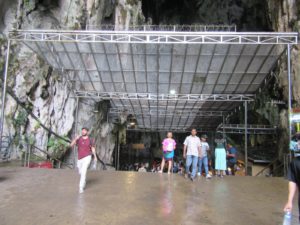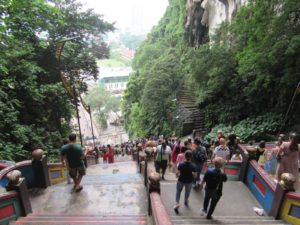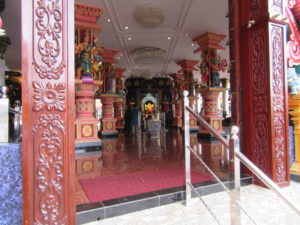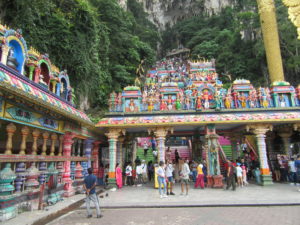By Priyan R Naik
 When I set off to visit one of Kuala Lumpur’s must see places, the Batu Caves, a limestone cave complex in Malaysia, located 13 km to the north of the capital city, I was reminded of Meghalaya’s Mawsmai Cave located 6 km from Sohra. I recollected visiting the Mawsmai Cave with its astonishing limestone rock formations. Formed naturally, marginally acidic rainwater had carved complicated passageways, chambers, and formations inside with stalactites maintained from the ceiling and stalagmites formations creating a labyrinth of spellbinding structures. The caves were pretty well-lit, with some parts large enough to stand upright and observe the play of shadows on the rocks.
When I set off to visit one of Kuala Lumpur’s must see places, the Batu Caves, a limestone cave complex in Malaysia, located 13 km to the north of the capital city, I was reminded of Meghalaya’s Mawsmai Cave located 6 km from Sohra. I recollected visiting the Mawsmai Cave with its astonishing limestone rock formations. Formed naturally, marginally acidic rainwater had carved complicated passageways, chambers, and formations inside with stalactites maintained from the ceiling and stalagmites formations creating a labyrinth of spellbinding structures. The caves were pretty well-lit, with some parts large enough to stand upright and observe the play of shadows on the rocks.
 Over 400 million years old, the Batu caves were organically formed from existing limestone hills. The caves are accessible through an iconic coloured staircase with 272 steps painted in vibrant shades of red, yellow, blue and green and is home to a beautiful temple nestled in the heart of the cave. A tall golden statue of Lord Murugan, 140 feet in height, adorns the entrance at the base. I had chosen to come here in the morning to avoid the jostling crowds making it possible to better appreciate the beauty and atmosphere of the cave complex.
Over 400 million years old, the Batu caves were organically formed from existing limestone hills. The caves are accessible through an iconic coloured staircase with 272 steps painted in vibrant shades of red, yellow, blue and green and is home to a beautiful temple nestled in the heart of the cave. A tall golden statue of Lord Murugan, 140 feet in height, adorns the entrance at the base. I had chosen to come here in the morning to avoid the jostling crowds making it possible to better appreciate the beauty and atmosphere of the cave complex.
Being a religious area, people had to be respectfully dressed and those visitors who had not dressed appropriately had to rent cover-ups which were available in shops nearby. The need to climb the 272 steps to reach the main cave entrance was a challenge akin to taking a workout. I found myself pausing several times at various landings, the colourful steps looking beautiful on the way up.
 The Batu Caves complex is home to many monkeys, a source of bother with troops of monkeys playing about in the area. Right from the foot of the stairs, all the way to the entrance of the temple, monkeys were gamboling and scampering around the grounds waylaying people and grabbing food stuff wherever and whenever possible. They were clearly very used to people and were quite brazen.
The Batu Caves complex is home to many monkeys, a source of bother with troops of monkeys playing about in the area. Right from the foot of the stairs, all the way to the entrance of the temple, monkeys were gamboling and scampering around the grounds waylaying people and grabbing food stuff wherever and whenever possible. They were clearly very used to people and were quite brazen.
Finally, I reached the top and after spending a few more minutes recovering from the steep climb, I was at the main cave. With ceilings reaching 100 meters, the sheer size and beauty of the cave took my breath away. Meghalaya’s Mawsmai caves seemed tiny in comparison, but the sunlight streaming through various openings of the cave was a treat to behold just as in the Mawsmai caves. Inside were a series of ornate shrines, altars, and statues dedicated to various deities. Going deeper into the cave complex, I came across several smaller caves, with their own unique features and spiritual significance.
 After spending an hour basking in the beauty of the caves, exploring the smaller ones, taking several pictures, I got myself mentally prepared to descend. The way back was easier and though the colorful stairs were not clearly visible, the spectacular view of tree tops and the surrounding foliage more than made up for it.
After spending an hour basking in the beauty of the caves, exploring the smaller ones, taking several pictures, I got myself mentally prepared to descend. The way back was easier and though the colorful stairs were not clearly visible, the spectacular view of tree tops and the surrounding foliage more than made up for it.
To return to the city, I chose to use Kuala Lumpur’s Komuter train to avoid the city’s notorious traffic. The station was a brief 5-minute stroll away and the train deposited me at the city center in 40 minutes.
So which cave complex is worth visiting? Keeping an image of the Mawsmai caves in my mind, I found the Batu Cave complex on the limestone hill was primarily a Hindu pilgrimage site representing Hindu culture while the Mawsmai Caves also natural limestone caves are known more for their stalactites and stalagmites and reflected local Khasi traditions. Undeniably both Batu and Mawsmai caves are set in picturesque environments, surrounded by lush greenery and scenic landscapes, limestone caves formed through similar geological processes, showcasing impressive rock formations. Both a must see for everybody!
******
(Priyan R Naik is a regular contributor at The Shillong Times)



